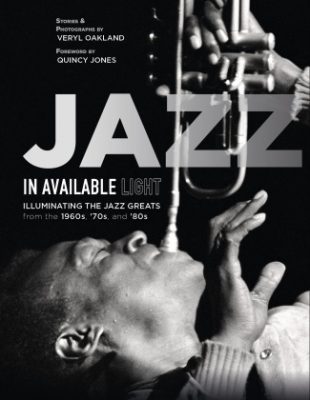.
.
.
Jazz in Available Light, Illuminating the Jazz Greats from the 1960s, ’70s, and ’80s is one of the most impressive jazz photo books to be published in a long time. Featuring the brilliant photography of Veryl Oakland — much of which has never been published — it is also loaded with his often remarkable and always entertaining stories of his experience with his subjects.
With the gracious consent of Mr. Oakland — an active photojournalist who devoted nearly thirty years in search of the great jazz musicians — Jerry Jazz Musician regularly publishes a series of posts featuring excerpts of the photography and stories/captions found in this important book.
In this edition, Mr. Oakland’s photographs and stories feature Stan Getz, Sun Ra, and Carla Bley.
.
.
All photographs copyright Veryl Oakland. All text excerpted from Jazz in Available Light, Illuminating the Jazz Greats from the 1960s, ’70s, and ’80s
.
You can read Mr. Oakland’s introduction to this series by clicking here
.
.
_____
.
.
STAN GETZ (Stanley Gayetsky)
tenor saxophone
Born: February 2, 1927
Died: June 6, 1991
.
.
© Veryl Oakland
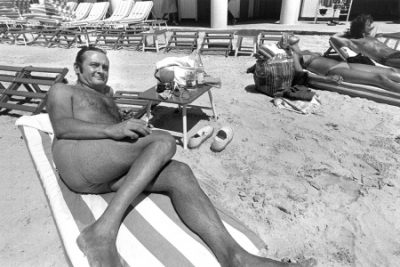
After finishing a vigorous swim in the Mediterranean Sea, Stan Getz relaxes on the beach in front of his hotel in Antibes, France
.
___
.
The Stars Align:
“Stars” Intertwine
.
San Francisco, California
The last time we had visited was a couple of summers earlier. Stan Getz had been relaxing on the beach in front of his hotel, Le Grand Pavois in Antibes, France, after an invigorating swim in the Mediterranean Sea’s Bay of Cannes. As a sun worshiper and outstanding swimmer, he relished performing at such waterfront jewels as the Juan-Les-Pins Jazz Festival where he was one of the top headliners.
…..On this occasion, in February of 1978, the tenor saxophonist was back in San Francisco preparing for a new engagement at the popular jazz club Keystone Korner. I had made arrangements several weeks earlier to do a photo session with him one he arrived in the City, but I could never have envisioned just how fitting the day would turn out to be. Recalling how the afternoon’s events unfolded, it was almost as if the stars were in perfect alignment.
…..When I picked him up at his hotel, Stan was in great spirits, primarily because he was reconnecting with one of his all-time favorite musical collaborators, Bob Brookmeyer. The valve trombonist, having last worked with Getz some fourteen years earlier, had just rejoined him for the start of a new tour beginning on the west coast.
© Veryl Oakland 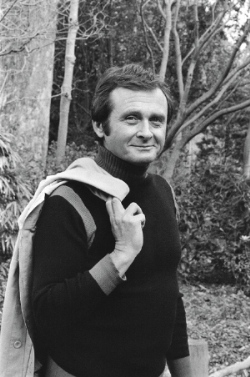
…..When we got into the car, I asked him if he wanted to do anything in particular. He said he just felt like taking in different parts of the city. We did some sightseeing, driving through North Beach, out along the Marina, and then I headed over to Golden Gate Park. After parking, we went for a leisurely walk of the grounds, even stopping along the way to pick and eat wild blackberries. Next we visited the de Young Museum, where we spent quite a bit of time viewing the many artworks, and finally ended up browsing through the grounds of the Japanese Tea Garden, where we stopped to take some photographs.
…..Throughout the day, Getz periodically expressed his delight in being reunited with Brookmeyer after so many years. It was obvious the two of them shared a strong musical bond.
…..Upon returning to his hotel, Stan asked me to bring my gear and come into the lobby with him while he changed clothes. Before going upstairs, he picked up a house phone and called Brookmeyer in his room. “C’mon down,” he told Bob, “we need to take some pictures together.” When Brookmeyer arrived, the three of us walked a couple of blocks to the financial district for some photos of the utterly compatible pair.
…..During my years of covering Stan Getz, I always found him cordial but occasionally preoccupied, perhaps dealing with something personal. If I sensed he was distracted or concerned about more pressing matters, I gave him some space. In part, what made this day so special was how open-armed and “free” he seemed.
…..Thinking back on that memorable afternoon, I often reflect on the absolute good fortune of being so close with the man I consider to be the most distinctive melodious creator of music on the tenor saxophone. Not only was the day particularly meaningful for me, but also fortuitous in that I got to share some fleetingly happy times with two clearly simpatico artists whose musical minds were so closely attuned.
…..In Donald L. Maggins book, Stan Getz: A Life in Jazz, the saxophonist talked about the close ties he enjoyed with Brookmeyer: “We seem to be on the same wave-length musically and personally. We complement each other naturally…[and] have the same yearning for fresh, uncluttered, melodic improvisation.
.
.
© Veryl Oakland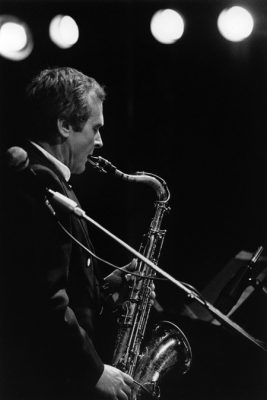
.
.
*
.
.
Click to listen to Stan Getz and Bob Brookmeyer play “Who Could Care?” (from 1961)
.
.
.
.
_____
.
.
.
SUN RA (Herman Poole “Sonny” Blount) (Le Sony’r Ra)
Piano, composer, synthesizer, electric keyboards, leader, educator
Arrival Day: May 22, 1914
Departure Day: May 30, 1993
.
.
© Veryl Oakland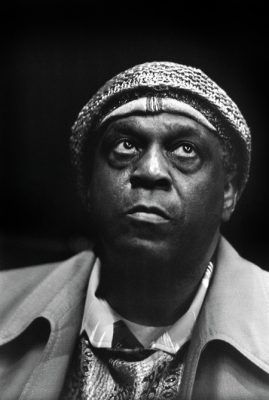
.
In His Own “Space”
.
“I play the music of the universe. If humans should one day hear the sounds of cosmic beings from different worlds, their music will sound familiar, because they will have heard Sun Ra on Earth.”
Sun Ra, from Jazz: A Photo History, by Joachim-Ernst Berendt
.
Philadelphia, Pennsylvania
It didn’t matter that many writers dismissed Sun Ra as a gimmick or a put-on. He personified and even celebrated his “otherworldly” image and existence. He delighted in promoting his unique brand. Wherever in the world he performed, the crowds would follow. And in the end, he survived as one of jazz’s most prolific recording artists of the twentieth century.
…..My first couple of sessions witnessing Sun Ra and his Solar Arkestra occurred in the San Francisco Bay Area in the mid-1970s. During a conversation after he had completed a soundcheck at a Berkeley concert hall, I told him I was expecting an assignment to cover him in his familiar surroundings back east. We shared contact information and I told him that I’d be in touch.
…..While covering the Newport in New York Jazz Festival in the summer of 1979, I called him at his home in Philadelphia about doing a special photo shoot. Despite not having any pressing business in New York at the time, he offered to make the long trip by subway. When I picked him up at Penn Station, he showed me a satchel containing costumes, earphones, head coverings, and other assorted paraphernalia to “…liven up the photos.”
…..After the session, we had dinner together at a Thai restaurant that he liked. Before he left to check into a hotel for the night, we agreed it would be good to meet once more on his own home turf for a more personal and extended photo session. I told him I’d be back the following July.
…..The next year prior to the Newport Festival, I tracked him down by telephone while he was in Boston preparing to present what he described as an “…Outer space Visual Communicator light show,” at the Massachusetts College of Art and Design (the OVC was developed by scientist Bill Sebastian). He told me when he would be due back home. We set the time then for our photo shoot in Philly.
…..The day of our meeting, I took the hour-and-a-half subway ride from Penn Station to 30th Street Station in Philadelphia. As pre-arranged, Danny Ray Thompson, baritone saxophonist and road manager, picked me up, and we drove to Sun Ra’s 5626 Morton Street home in the nearby suburb of Germantown.
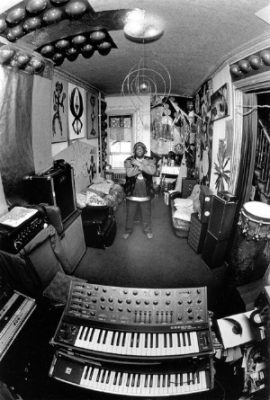
I actually wasn’t even aware that Sun Ra had made some minor garment changes along the way for each of the different poses we did in and around his home
…..After we arrived, I was ushered into a long room on the main floor. It was packed wall-to-wall with recording equipment, speakers, amplifiers, paintings, murals, tapestries, pieces of sculpture, a drum set, two makeshift couches piled high with overstuffed pillows, even a portable television set.
…..While I was photographing the main room’s interior, Sun Ra appeared. He explained that this was his group’s “rehearsal room.” He promptly opened a movable divider closest to the street, went around, and sat down on a bench accompanying his large Crumar brand organ.
…..On this occasion, he made five changes of flashy outerwear and headgear. We took photographs in the main room and around the house, in some outdoor settings, and with several members of his Arkestra.
…..After completing the photos, we returned to his rehearsal room and talked for more than an hour. He discussed many topics, offering opinions on a variety of subjects, fellow musicians, and prior experiences that ran the gamut of believability. Sun Ra alluded to his “advanced” state and how people were unable to accept him because of it.
…..He referred specifically to a manuscript he had written, The Immeasurable Equation, which he offered to Doubleday, the book publisher. Doubleday kept it for three months, said they could not decipher it, and finally gave it back to him, explaining, “It might as well have been written in a foreign language.” Despite this, Sun Ra noted that Impulse Records had re-released one of his albums – the 1973 disc, Astro Black – which included seven of his verses from that manuscript in the sleeve. He said that what he had written about was the “cosmos” and the “ultimate in truths,” explaining that his words do not relate to human standards.
…..Sun Ra told me that by cosmos standards, he was three years old, but noted that he had existed “…for several lifetimes and one ‘so-called lifetime,’” the latter referring to his current presence on Earth.
An example of Sun Ra’s typeset verse
…..As if to authenticate what he was saying, he gave me seven pages containing thirty-seven examples of typeset verse printed on both sides of faded blue paper, representing a portion of his manuscript. The pieces ranged from a short, few lines to others extending a half-page in length, each bearing its own title. Before finishing up talking about his manuscript, he picked up a simple protractor and, without saying anything, drew a half-inch circle with a dot in the middle of one of his verses title “On.”
…..Far more understandable were Sun Ra’s remarks about other musicians and how they were influential in shaping the future of jazz. The biggest influence on him and the development of his music was composer/arranger/bandleader Fletcher Henderson, with whom he worked as pianist and arranger in 1946-47. It was Henderson who prompted Sun Ra to organize his first Arkestra in Chicago 1954 (so-named because the first and last two letters backward and forward spelled his name). As if implying that some strange bond existed between he and Fletcher Henderson, Sun Ra told me that Fletcher’s band members “…always thought I played weird,” but quickly countered with, “Fletcher played piano; I played piano. That’s why he hired me.”
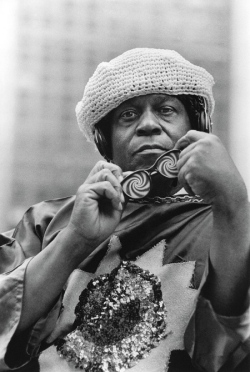
…..He recalled how Henderson asked him to bring some of his own arrangements for the band to play. “I remember bringing ‘I Should Care,’” he said with a smirk, “but the band couldn’t play it, even after two hours. I’ve had teenage students, thought,” he continued, “who could play the charts because I’m able to bring out musicians’ abilities after working with them.”
…..Several times Sun Ra appeared to enjoy poking fun at Henderson’s band members, but had only the highest praise for Fletcher himself. Regarding the popular bandleader’s skills as an arranger, he said to me, “Fletcher’s ‘King Porter Stomp’ was the best jazz feeling ever written. Everything he wrote was meticulously correct.” Sun Ra’s ongoing dedication to Henderson was obvious. During our time together, he explained that when he and the band weren’t traveling, the Arkestra members rehearsed in his home almost every day. “…[and] when we’re not rehearsing, I play them Fletcher Henderson records.”
…..Sun Ra spoke at length about his personal qualities as a teacher, healer, and seer. He noted that a lot of musicians received the wrong upbringing and weren’t educated properly Regarding the very diverse styles of pianists Oscar Peterson and Paul Bley, he said, “Oscar plays like a machine, never making a mistake. Paul Bley will take chances and make a mistake, but it comes off right.”
…..Besides receiving the proper kind of musical education, Sun Ra stressed that artists need to “…do what’s right for themselves. The most thing for black people,” he said, “is to produce what they feel, not what they think.”
.
.
© Veryl Oakland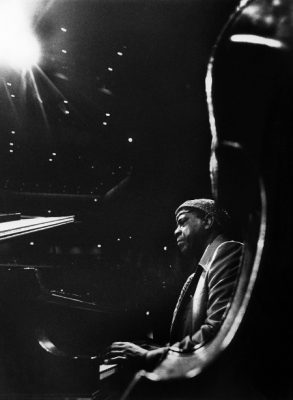
.
.
*
.
.
Click to listen to Sun Ra play “Space is the Place”
.
.
.
.
_____
.
.
.
CARLA BLEY (nee Carla Borg)
Composer, piano
Born: May 11, 1936
.
© Veryl Oakland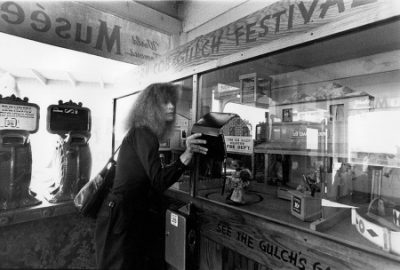
Carla Bley at the Musee Mechanique arcade, San Francisco, 1979
.
___
.
San Francisco, California
When interacting with particularly gifted people, I discovered early on that it was always best to just remain loose – be prepared for the unpredictable.
…..It was early in 1979 that I learned Carla Bley would be making her visit home to the Bay Area in fifteen years. After tracking down the brilliant composer and explaining what I wanted to do, she set the time, date, and location for our meeting. Before hanging up, all she said was, “Meet me at the Cliff House…at the Musee Mechanique arcade.”
…..I had no idea why we would meet at a music arcade. But it turned out that this little playground jewel of Carla’s was the genesis of her most recent album, completed just the previous November, entitled Musique Mecanique: The Carla Bley Band. A later review of Musique Mecanique read, “The three-part title piece of the album evokes, in glorious musical portraiture, the marvelous inner workings of mechanical music boxes.”
…..Arriving that day at the Cliff House, I found my way down the steps and around the back, which faced the ocean. At this odd spot was the arcade, a series of glass-enclosed window boxes containing all sorts of mechanical musical contraptions and scores of metallic, moving figures. People would deposit their quarters and the musical machines came to life.
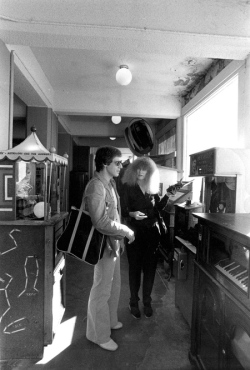
Bley and Mantler in the arcade
…..The random displays, featuring one box after another, included the likes of “The Unbelievable Mechanical Farm,” complete with sounds of moving windmills, tractors, and farm animals; the “Laughing Sal” mannequin; “The Corn Cob Gulch Festival and Volunteer Fire Department;” the “Dueling Buffaloes;” and the “Marionettes, Puppet, and Monkey Band.”
…..Again, I wondered what we were doing here as I watched kids running around playing with the enigmatic machines, and then Carla Bley appeared along with her-then-husband Michael Mantler.
…..Just like the kids, she sprung to life; it was obvious that this place held pure magic and was once again reigniting fond memories dating all the way back to when Carla had first come here with her father at age eleven. Without uttering a word, the two entered the arcade and began depositing quarters in the different machines. Flitting about the room with her recorder, Carla captured the cacophony of competing noises blasting from the different machines, while Mantler watched what had inspired her from so many years ago.
…..Sitting down afterwards, Carla explained that what had fascinated her most during her many trips to the arcade was the malfunctioning of the mechanical boxes. “I loved the broken machines,” she told me. “Those sounds have remained in my head to this day. Wrong notes and getting stuck were two of my favorite things.”
…..Listening to that quirky little album some time later, it was almost as if I could hear her fertile mind at work.
.
© Veryl Oakland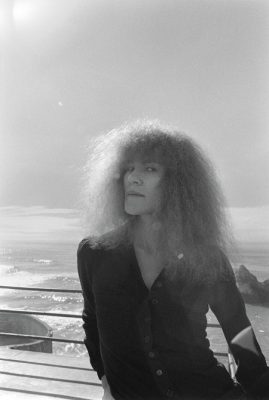
.
.
*
.
.
Click to listen to Carla Bley play “Musique Mecanique 1”
.
.
___
.
.
Click here to read the edition featuring Stan Getz, Sun Ra and Carla Bley
Click here to read the edition featuring Art Pepper, Pat Martino and Joe Williams
Click here to read the edition featuring Yusef Lateef and Chet Baker
Click here to read the edition featuring Mal Waldron, Jackie McLean and Joe Henderson
.Click here to read the edition featuring Dexter Gordon, Art Farmer and Johnny Griffin
Click here to read the edition featuring Thelonious Monk, Paul Bley and Cecil Taylor
Click here to read the edition featuring drummers Jo Jones, Art Blakey and Elvin Jones
Click here to read the edition featuring Monk Montgomery and the jazz musicians of Las Vegas
Click here to read the edition featuring Sarah Vaughan and Better Carter
.
.
_____
.
.
.
.
All photographs copyright Veryl Oakland. All text and photographs excerpted with author’s permission from Jazz in Available Light, Illuminating the Jazz Greats from the 1960s, ’70s, and ’80s
.
You can read Mr. Oakland’s introduction to this series by clicking here
Visit his web page and Instagram
.
.
.




